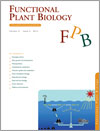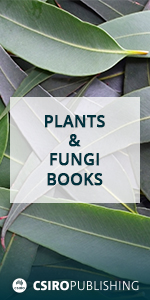
Functional Plant Biology
Volume 41 Number 5 2014
FP13247Photophysiological responses of marine diatoms to elevated CO2 and decreased pH: a review
Marine diatoms show diverse growth responses to increasing pCO2 and the associated changes to seawater carbonate system. These responses reflect physiological diversities across diatoms, but also complex interactions among responses to pCO2, pH, nutrient availability, light levels and fluctuations. Predicting net diatom growth responses to ocean acidification will require integrated measures.
FP13247 Abstract | FP13247 Full Text | FP13247PDF (294 KB) Open Access Article
FP13257The rate of drying determines the extent of desiccation tolerance in Physcomitrella patens
This paper presents new results indicating that Physcomitrella patens (the model organism for bryophytes) is desiccation tolerant. We provide a method to induce desiccation tolerance with supporting evidence for tolerance. This work provides an outline for future studies on desiccation using an organism both amenable to cultivation and in possession of a fully sequenced genome.
FP13237Soil water availability influences the temperature response of photosynthesis and respiration in a grass and a woody shrub
Understanding the interactive effects of temperature and water availability on plant carbon exchange is essential to predict the impact of environmental changes on plant productivity. Here, soil drying was used to determine the short-term temperature response of photosynthesis and respiration under varying soil water contents, and to resolve their combined effects. Water availability influenced the temperature sensitivity of photosynthesis and respiration, and altered the balance between carbon gain and loss.
FP13232More fertile florets and grains per spike can be achieved at higher temperature in wheat lines with high spike biomass and sugar content at booting
To keep wheat productive under high temperature and long photoperiod requires an understanding of processes regulating floret and grain number. Genotypes with high stem soluble carbohydrates had slower floret development and higher grain set at high temperature, higher spike biomass, higher glucose and more florets and grains per spike across environments. Our findings highlight an interaction between carbohydrates and floret development that could be exploited in warmer environments.
FP13232 Abstract | FP13232 Full Text | FP13232PDF (611 KB) | FP13232Supplementary Material (48 KB) Open Access Article
FP13204Changes in the concentration of organic acids in roots and leaves of carob-tree under Fe deficiency
Carob tree is a crop well adapted to calcareous soils that does not develop iron (Fe) chlorosis. The lack of Fe triggers an increase of organic acids and activity of the root ferric chelate-reductase as response mechanisms. Understanding physiological mechanisms of this species could improve the strategy to cope with nutritional imbalances and avoid excessive application of fertilisers.
FP13249Drought resistance and soil water extraction of a perennial C4 grass: contributions of root and rhizome traits
Soil water extraction by perennial grasses under drought conditions is not well understood but has important implications for agricultural productivity as the climate changes. We studied the variation among 18 bermudagrasses for soil water extraction and drought resistance in a drying soil profile. We found that drought resistance was associated with rhizome production rather than rooting depth and root distribution.
FP13240Xylem as the main origin of stem radius changes in Eucalyptus
Tree stems shrink and expand in radius with transpiration-induced negative pressures. So far, these fluctuations have mainly been related to shrinkage in living cells of the bark which act as a buffer for water potential peaks in the rigid water transport system of the wood. Here we propose that Eucalyptus globulus as a fast-growing species maintains immature, non- or partially lignified xylem which acts as an additional water storage in the sapwood and, thus, alters the performance of the water supply system of the entire tree.
FP13223Vapour pressure deficit aids the interpretation of cotton canopy temperature response to water deficit
Canopy temperature has been identified as a real-time, plant-based tool which may provide gains in irrigation efficiency. However, canopy temperature response to water stress is confounded by environmental conditions. In order to better use canopy temperature for irrigation scheduling, the relationship between environmental conditions and plant water stress physiology was explored. From this research we conclude that point-in-time measures of canopy temperature for water stress detection are better understood with the inclusion of atmospheric vapour pressure deficit.
FP13217Impact of light on leaf initiation: a matter of photosynthate availability in the apical bud?
Leaf initiation rate (LIR) is strongly modulated by temperature and commonly predicted solely based on thermal time. We investigated the effects of photosynthetic photon flux density (PPFD) on LIR in cucumber and tomato plants. LIR and photosynthate availability in the apical bud substantially decreased at low PPFD in both species suggesting that PPFD is limiting for LIR most likely via photosynthate availability in the apical bud.




